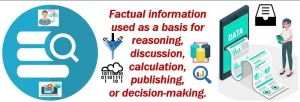Data means information, greater especially facts, figures, measurements and amounts that we acquire for evaluation or reference. The time period’s which means additionally consists of descriptive records approximately things, plants, animals, and human beings. We gather and store data generally thru observation.

We acquire facts and numbers, which we examination and recollect while looking to make, for instance, a enterprise decision. These facts and figures are data, as is electronic information that we store, and our computer systems or smartphone use.
Data is the plural of datum. However, maximum human beings generally tend to apply the phrase data for each the plural and singular forms.
The Cambridge Dictionary has the following definition of the term:
“Information, particularly facts or numbers, gathered to be tested and taken into consideration and used to assist decision-making, or information in an digital form that may be saved and utilized by a pc.”
Quantitative and qualitative data
For scientists, mathematicians, statisticians, entrepreneurs, and lawmakers, there are foremost kinds of data:
- Qualitative – it describes things, i.e., it is descriptive information.
- Quantitative – numerical records, i.e., numbers, statistics, measurements, etc.
Let’s examine an instance of the 2 kinds in a context:
What will we know about Sammy the Cat?

Sammy the Cat information
- Qualitative
- He is black throughout besides for his paws, chest, chin, and a part of his tummy, which might be white.
- His hair is short-to-medium in length.
- He spends maximum of the day asleep and has a tendency to exit at night.
- Quantitative
- His tail is 30cm (18″) long.
- He weighs 5kg (11.2lbs).
- Sammy has one sister and one brother.
- He is 40cm (15.7″) long (excluding tail).
Big data

Big data includes as a minimum one petabyte of information. One petabyte (PB) is 1015 or 10,000,000,000,000,000 bytes of digital information. We describe it as having the 5Vs: value, volume, variety, velocity, and veracity.
Wikipedia.org says the following:
“Big data is a area that treats approaches to examine, systematically extract information from, or in any other case deal with data units which can be too massive or complicated to be handled through traditional data-processing application software.”
In these days’s fiercely aggressive marketplace, organizations are daily inundated with huge volumes of data; each unstructured and structured. However, what matters isn’t always how much information there is, however what businesses do with it. CEOs and individuals of senior control examine those big pools of records for insights that may assist them expect effects and make better decisions.
In the retail sector, massive data these days has grow to be essential. Without it, any online shop might battle to compete effectively.
According to sas.com, if we analyze this type of information carefully, we might achieve the following benefits for our businesses:
- Lower costs.
- Better use of time.
- Development of new products.
- Optimized offerings.
- Smarter decision-making.
Sas.com makes the following comment about how we use business information today:
“Big data – and the way organizations control and derive perception from it – is converting the manner the arena makes use of business information.”
Etymology
Etymology refers to in which words come from. It additionally consists of the have a take a observe of the way the meanings of phrases advanced over time. Did you recognize that the word best as soon as intended silly, simple, or foolish? Awful used to intend worth of awe.
The term Data first emerged in the English language the 1640s. At that time, it intended “a fact given or granted.” It turned into the classical plural of Datum, which got here from the Latin word Datum, which intended “(thing) given.” The Latin phrase for Give is Dare. Datum is the beyond participle of Dare.
The term did now no longer gather the which means “numerical records gathered for destiny reference” till 1897.
It entered the arena of computing jargon in 1946, with the which means “transmittable and storable records through which pc operations are performed.”
The phrases records processing, database, and records access regarded in 1954, 1962, and 1970 respectively.

